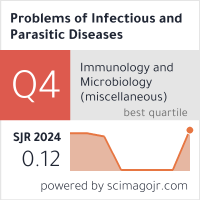APPLICATION OF PCR METHOD FOR DETECTION AND SPECIES IDENTIFICATION OF TOXOCARA SPP.
DOI:
https://doi.org/10.58395/pipd.v48i3.46Keywords:
Toxocara spp., PCR, ITS-2, molecular identificationAbstract
The ascaridoid nematodes of dogs and cats T. canis and T. cati are with widespread distribu-tion and causative agents of a disease in human and animals named Toxocariasis. Human dis-ease has several clinical forms with different clinical manifestation such as visceral, ocular, neurotoxocariasis and covert toxocariasis. The morphological methods used to differentiate the two species, especially to identify eggs or larvae, can lead to inaccurate diagnosis. This requires the use of more reliable methods, such as PCR, for identification of Toxocara species.
The aim of our research is to develop in our conditions a PCR method for species identification of Toxocara and to determine its applicability on different stages of parasites.
The method used by Khademvatan et al. (2013), we performed with some modifications in different forms of Toxocara - eggs, larvae and adult parasites. We used species-specific oligonucleotide primers from the ITS2 gene sequence of the ribosomal DNA - Tcan1/NC2 for T. canis and Tcat1/NC2 for T. cati.
The presence of a band with a size of 380 bp, specific for T. canis, was found for all stages of the studied parasite.
The described method will allow species differentiation of Toxocariasis causative agents and improve the diagnosis of the disease, as well as determine the actual spread and reservoirs of these parasites.
Downloads
References
Overgaauw P, van Knapen F. Veterinary and public health aspects of Toxocara spp. Vet Parasitol. 2013; 193:398–403.
Macpherson C. The epidemiology and public health importance of toxocariasis: a zoonosis of global importance. Int J Parasitol. 2013; 43:999–1008.
Beaver P, Snyder C, Carrera G, Dent J, Lafferty J. Chronic eosinophilia due to vis-ceral larva migrans: report of three cases. Pediatrics. 1952; 9:7–19.
Wilder H. Nematode endophthalmitis. Trans Am Acad Ophthalmol Otolaryngol. 1950; 55:99–109.
Finsterer J, Auer H. Neurotoxocarosis. Rev Inst Med Trop Sao Paulo. 2007; 49:279-287.
Taylor M, Keane C, O’Connor P, Mulvihill E, Holland C. The expanded spectrum of toxocaral disease. Lancet. 1988; 1(8587):692-695.
Glickman L, Schantz P. Epidemiology and pathogenesis of zoonotic toxocariasis. Epidemiol Rev. 1981; 3:230-250.
Nichols R. The etiology of visceral larva migrans. I. Diagnostic morphology of in-fective second-stage Toxocara larvae. J Parasitol. 1956; 42:349–362.
Gasser R. Molecular tools - advances, opportunities and prospects. Vet Parasitol. 2006; 136:69-89.
Zhu X, Jacobs D, Chilton N, Sani R, Cheng N, Gasser R. Molecular characteriza-tion of a Toxocara variant from cats in Kuala Lampur, Malaysia. Parasitology. 1998; 117:155-164.
Durant J-F, Irenge L, Wyrwas R, Dumont C, Doucet J, Mignon B, Losson B, Gala J. Duplex quantitative real-time PCR assay for the detection and discrimination of the eggs of Toxocara canis and Toxocara cati (Nematoda, Ascaridoidea) in soil and fecal samples. Parasites and Vectors. 2012; 5:288.
Rainova I. Development and characterization of ELISA and Western blot with ex-cretory/secretory antigens from Toxocara canis for diagnosis and prevalence study of toxoca-riasis in humans in our country. Dissertation. 2006, Sofia.
De Savigny D. In vitro maintenance of Toxocara canis larvae and a simple method for the production of Toxocara ES antigen for use in serodiagnostic tests for visceral larva migrans. J Parasitol. 1975; 61(4):781-782.
Borecka A, Gawor J. Modification of gDNA extraction from soil for PCR designed for the routine examination of soil samples contaminated with Toxocara spp. eggs. Journal of Helminthology. 2008; 82:119–122.
Wu Z, Nagano I, Xu D, Takahashi Y. Primers for polymerase chain reaction to detect genomic DNA of Toxocara canis and T. cati. Journal of Helminthology. 1997; 71:77-78.
Jacobs D, Zhu X, Gasser R, Chilton N. PCR-based methods for identification of potentially zoonotic ascaridoid parasites of the dog, fox and cat. Acta Tropica. 1997; 68:191–200.
Khademvatan S, Rahim F, Tavalla M, Abdizadeh R, Hashemitabar M. PCR-Based Molecular Characterization of Toxocara spp. Using Feces of Stray Cats: A Study from Southwest Iran. PLoS ONE. 2013; 8(6): e65293. doi:10.1371/journal.pone.0065293.
Lee N, Schantz P, Kazacos K, Montgomers S, Bowman D. Epidemiologic and zo-onotic aspects of ascarid infections in dogs and cats. Trends in Parasitology. 2010; 26:155-161.
Fogt-Wyrwas R, Jarosz W, Mizgajska-Wiktor H. Utilizing a polymerase chain reaction method for the detection of Toxocara canis and T.cati eggs in soil. J Helminthol. 2007; 81:75-78.
Li M, Lin R, Chen H, Sani R, Song H, Zhu X. PCR tools for the verification of the specific identity of ascaridoid nematodes from dogs and cats. Molecular and Cellular Probes. 2007; 21:349-354.
Pinelli E, Roelfsema J, Brandes S, Kortbeek T. Detection and identification of Toxocara canis DNA in bronchoalveolar lavage of infected mice using a novel real-time PCR. Veterinary Parasitology. 2013; 193:337-341.
Zyoud S. Global toxocariasis research trends from 1932 to 2015: a bibliometric analysis. Health research Policy and Systems. 2017; 15:14.
Kaneva E, Rainova I, Harizanov R, Nikolov G, Kaftandjiev I, Mineva I. Study of Toxocara seroprevalence among patients with allergy and healthy individuals in Bulgaria. Parasite Immunology. 2015; 37:505-509.
Kanchev K, Kamenov J, Salamitova K, Radeva P. Helminth status of domestic dogs with gastroenteritis in the region of Sofia. Traditions and modernity in veterinary medi-cine - 2014. Proceedings of the scientific conference. Sofia, 2016. ISSN 1313-4337.
Roth B, Schneider C. Untersuchungen zur Abha¨ngigkeit des ‘‘weissen Blutbildes’’ bei Hauskatzen (Felis domestica) von Wurminfektionen des Darmes. Berl Munch Tierarztl Wochenschr. 1971; 22:436–437.
Fahrion A, Schnyder M, Wichert B, Deplazes P. Toxocara eggs shed by dogs and cats and their molecular and morphometric species-specific identification: Is the finding of T. cati eggs shed by dogs of epidemiological relevance? Veterinary Parasitology. 2011; 177:186–189.






